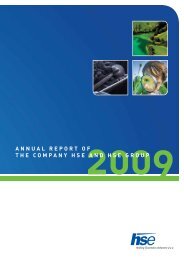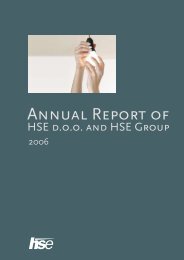ANNUAL REPORT - HSE
ANNUAL REPORT - HSE
ANNUAL REPORT - HSE
You also want an ePaper? Increase the reach of your titles
YUMPU automatically turns print PDFs into web optimized ePapers that Google loves.
• to ensure minimum deviations of production and of<br />
the balancing group from schedules,<br />
• to ensure an optimal distribution of power between<br />
available turbines,<br />
• to promptly activate reserve capacities in emergency<br />
situations.<br />
The quality of the management of the <strong>HSE</strong> balancing<br />
group is reflected in the minimisation of deviation<br />
costs thanks to the deviations of balancing group<br />
members being reduced through the adjustment of<br />
their production. In 2008 the <strong>HSE</strong> balancing group<br />
was comprised of the Group's production units, including<br />
small HPPs, PV and balancing subgroups of<br />
four distribution companies, Elektroprodaja and a few<br />
smaller consumers. The balancing group’s deviations<br />
include all production and consumption deviations<br />
from forecasted schedules. The <strong>HSE</strong> Group estimates<br />
that the management of the <strong>HSE</strong> balancing group was<br />
successful in 2008.<br />
Financial risks<br />
At the <strong>HSE</strong> Group, special attention is given to the financial<br />
risks to which the Group is exposed in its operations<br />
and to adopting measures for managing such<br />
risks.<br />
Solvency risk is the risk associated with insufficient<br />
financial sources and the resulting inability of the<br />
company to meet its commitments in due time. In the<br />
situation of the financial crisis, the solvency risk is a<br />
risk the management of which is one of the most important<br />
for the company. Short-term solvency is ensured<br />
by continuous matching and planning of cash<br />
flows. The <strong>HSE</strong> Group has established the monitoring<br />
and optimisation of short-term cash surpluses and<br />
deficits of group companies. The above system, the<br />
diversification of investments and liabilities, maturity<br />
matching of receivables and liabilities, consistent<br />
collection of receivables and a liquidity reserve in the<br />
form of credit lines granted by domestic and foreign<br />
banks facilitate the management of cash flows, which<br />
ensures the company’s and the Group’s payment capacity<br />
and a low level of short-term solvency risk.<br />
Moreover, good access to financing and markets, a<br />
high credit rating of the company thanks to its successful<br />
operations and the ability to keep generating<br />
cash flows from operating activities ensure that the<br />
solvency risk is estimated as moderate.<br />
In light of the conditions in the financial markets, the<br />
company also began to manage the risks of financial<br />
indiscipline of banks and financial institutions arising<br />
from investing of surplus cash. The risk is managed<br />
by observing the principle of dispersing deposits with<br />
individual banks and by monitoring information on the<br />
current operations of banks with which the company<br />
occasionally deposits surplus cash.<br />
The solvency risk is reduced by the high credit rating<br />
of the company which stems from its successful operations<br />
and by its ability to keep generating cash flows<br />
from operating activities.<br />
Credit risk represents the possibility that receivables<br />
will be settled only in part or will not be settled at all.<br />
The <strong>HSE</strong> Group manages credit risk through a thorough<br />
verification of customers' credit ratings, setting<br />
of limits, monitoring and managing of the credit exposure<br />
of individual partners with regard to their limits,<br />
and control over outstanding receivables.<br />
The controlling company has in place strategies and<br />
rules for the measurement and control of the company’s<br />
exposure to credit risks. The need for collaterals<br />
in respect of individual partners is determined based<br />
on rules which, among other things, lay down the setting<br />
of limits and monitoring of their utilisation. The<br />
electricity transactions that are based on annual contracts<br />
are mostly secured through bills of exchange or<br />
bank guarantees, with issuing banks having to satisfy<br />
strict credit rating criteria. Transactions with some<br />
partners are regulated in detail using EFET agreements.<br />
Short-term electricity trading transactions<br />
that are carried out on power exchanges are already<br />
secured through the obligatory membership system.<br />
Interest rate risk exposure comprises the possibility<br />
of an increase in the costs of variable interest rate financing<br />
at the source as a result of changing interest<br />
rates in the market. A portion of interest rates charged<br />
on long-term loans is hedged using appropriate derivatives<br />
through which a portion of variable interest<br />
rates is changed to fixed rates. The appropriateness<br />
and correctness of contracts aimed at hedging against<br />
interest rate risks is managed through the monitoring<br />
of developments in the European and global money<br />
market. Due to changes in the money market brought<br />
about by the global financial crisis, most interest rate<br />
hedging contracts were cancelled early in 2008. We<br />
estimate that thanks to the above measures regarding<br />
<strong>ANNUAL</strong> <strong>REPORT</strong> <strong>HSE</strong> | BUSINESS <strong>REPORT</strong><br />
79
















